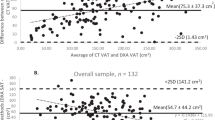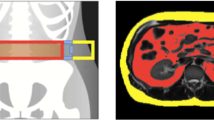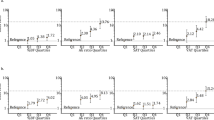Abstract
Objective: Recent studies support the possibility of estimating abdominal fat using a region of interest (ROI) selected by conventional whole body dual-energy X-ray absorptiometry (DXA). This is an important observation as DXA ROI estimates have some advantages over waist circumference or computed tomography/magnetic resonance imaging (MRI) as a means of assessing visceral adipose tissue (VAT) and adipose tissue distribution. The aim of this study was to evaluate the usefulness of DXA abdominal ROI estimates in assessing VAT among non-obese men.
Design: Observational, cross-sectional study comparing correlations between MRI-measured total VAT and surrogate measures including DXA ROIs. A stepwise multiple regression model was applied to derive a predictive equation with total VAT mass.
Subjects: Ninety non-obese healthy men between the ages of 18 and 44 y with BMI<30 kg/m2.
Measurements: Abdominal adipose tissue and total VAT were measured by whole body MRI; VAT area by single-slice MRI at the L4–5 level; specific DXA ROIs for abdominal regional fat defined as ROI A (L2–4), B (L2-upper iliac), C (lower costal-upper iliac), and D (ROI C excluding spine); and simple anthropometric measures.
Results: Correlations between total VAT and ROIs A (r=0.85) and B (r=0.84) were not significantly different from that of VAT area at L4–5 (r=0.87), but significantly higher (P <0.01) than that of waist circumference (r=0.77). The highest correlations with total abdominal adipose tissue were for DXA ROIs and conventional DXA trunk fat (r=0.95–0.97). A stepwise multiple regression analysis revealed that 86% of the variance in total VAT was predicted by VAT area at L4–5, ROI A, and waist-hip ratio.
Conclusions: DXA ROIs (L2–4, L2-upper iliac) were associated with total VAT as well as MRI-derived VAT area at L4–5 in non-obese men. DXA ROI fat distribution estimates may be useful in the early detection of men with abdominal/visceral obesity.
This is a preview of subscription content, access via your institution
Access options
Subscribe to this journal
Receive 12 print issues and online access
$259.00 per year
only $21.58 per issue
Buy this article
- Purchase on Springer Link
- Instant access to full article PDF
Prices may be subject to local taxes which are calculated during checkout

Similar content being viewed by others
References
Lapidus L, Bengtsson C, Larsson B, Pennert K, Rybo E, Sjostrom L . Distribution of adipose tissue and risk of cardiovascular disease and death: a 12 y follow up of participants in the population study of women in Guthenburg, Sweden Br Med J 1984 289: 1257–1261.
Donahue RP, Abbott RD, Bloom E, Reed DM, Yano K . Central obesity and coronary heart disease in men Lancet 1987 i: 822–824.
Ohlson L-O, Larsson B, Svardsudd K, Welin L, Eriksson H, Wilhelmsen L, Bjorntorp P, Tibblin G . The influence of body fat distribution on the incidence of diabetes mellitus 13.5 y of follow-up of the participants in the study of men born in 1913 Diabetes 1985 34: 1055–1058.
Seidell JC, Han TS, Feskens EJ, Lean ME . Narrow hips and broad waist circumferences independently contribute to increased risk of non-insulin-dependent diabetes mellitus J Intern Med 1997 242: 401–406.
Terry R, Page W, Haskell W . Waist/hip ratio, body mass index and premature cardiovascular disease mortality in US Army veterans during a twenty-three year follow-up study Int J Obes Relat Metab Disord 1992 16: 417–423.
Rexrode KM, Carey VJ, Hennekens CH, Walters EE, Colditz GA, Stampfer MJ, Willett WC, Manson JE . Abdominal adiposity and coronary heart disease in women JAMA 1998 280: 1843–1848.
Despres JP, Ross R, Lemieux S . Imaging techniques applied to the measurement of human body composition In: Roche AF, Heymsfield SB, Lohman TG Human body composition Human Kinetics: Chicago, IL 1996 pp 149–166.
Molarius A, Seidell JC . Selection of anthropometric indicators for classification of abdominal fatness—a critical review Int J Obes Relat Metab Disord 1998 22: 719–727.
Heymsfield SB, Allison DB, Wang Z-M . Evaluation of total and regional body composition In: Bray GA, Bouchard C, James WPT Handbook of obesity Marcel Deker: New York 1998 pp 52–54.
Ross R, Pedwell H, Rissanen J . Effects of energy restriction and exercise on skeletal muscle and adipose tissue in women as measured by magnetic resonance imaging Am J Clin Nutr 1995 61: 1179–1185.
Harris TB, Visser M, Everhart J, Cauley J, Tylavsky F, Fuerst T et al. Waist circumference and sagittal diameter reflect total body fat better than visceral fat in older men and women: the health, aging and body composition study Ann NY Acad Sci 2000 904: 462–473.
Ross R, Leger L, Morris D, De Guise J, Guardo R . Quantification of adipose tissue by MRI: relationship with anthropometric variables J Appl Physiol 1992 72: 787–795.
Schlemmer A, Hassager C, Haarbo J, Christiansen C . Direct measurement of abdominal fat by dual photon absorptiometry Int J Obes Relat Metab Disord 1990 14: 603–611.
Svendsen OL, Hassager C, Bergmann I, Christiansen C . Measurement of abdominal and intraabdominal fat in postmenopausal women by dual X-ray absorptiometry and anthrometry: comparison with computerized tomography Int J Obes Relat Metab Disord 1993 17: 45–51.
Taaffe DR, Lewis B, Marcus R . Regional fat distribution by dual-energy X-ray absorptiometry: comparison with anthropometry and application in a clinical trial of growth hormone and exercise Clin Sci 1994 87: 581–586.
Jensen MD, Kanaley JA, Reed JE, Sheedy PF . Measurement of abdominal and visceral fat with computed tomography and dual-energy x-ray absorptiometry Am J Clin Nutr 1995 61: 274–278.
Treuth MS, Hunter GR, Kekes-Szabo T . Estimating intraabdominal adipose tissue in women by dual-energy X-ray absorptiometry Am J Clin Nutr 1995 62: 527–532.
Jebb SA . Measurement of soft tissue composition by dual energy X-ray absorptiometry Br J Nutr 1997 77: 151–163.
Roubenoff R, Kehayias JJ, Dawson-Hughes B, Heymsfield SB . Use of duel-energy absorptiometry in body composition studies: not yet a ‘gold standard’ Am J Clin Nutr 1993 58: 589–591.
Roubenoff R, Kehayias JJ, Dawson-Hughes B, Heymsfield SB . Use of dual-energy X-ray absorptiometry in body composition studies: not yet a ‘gold standard’ Am J Clin Nutr 1993 58: 589–591.
Gallagher D, Belmonte D, Deurenberg P, Wang J, Krasnow N, Pi-Sunyer FX, Heymsfield SB . Organ tissue mass measurement allows modeling of resting energy expenditure and metabolically active tissue mass Am J Physiol 1998 275: E249–E258.
Kamel EG, McNeill G, Van Wijk MCW . Usefulness of anthropometry and DXA in predicting intraabdominal fat in obese men and women Obes Res 2000 8: 36–42.
Clasey JL, Bouchard C, Teates CD, Riblett JE, Thorner MO, Hartman ML, Weltman A . The use of anthropometric and dual-energy X-ray absorptiometry measures to estimate total abdominal and abdominal visceral fat in men and women Obes Res 1999 7: 256–264.
Ross R . Magnetic Resonance Imaging provides new insights into the characterization of adipose and lean tissue distribution Can J Clin Pharmac 1996 74: 778–785.
Gallagher D, Kovera AJ, Clay-Williams G, Agin D, Albu LJ, Matthews DE, Heymsfield SB . Weight loss in post-menopausal women: no evidence of adverse alterations in body composition Am J Physiol Endocrinol Metab 2000 279: 124–131.
Snyder WS, Cook MJ, Nasset ES, Karhausen LR, Howells GP, Tipton IH . Report of the Task Group on Reference Man International Commission on radiological protection, no. 23 Pergamon Press: Oxford 1975.
Kamel EG, McNeill G, Han TS, Smith FW, Avenell A, Davidson L, Tothill P . Measurement of abdominal fat by magnetic resonance imaging, dual-energy X-ray absorptiometry and anthropometry in non-obese men and women Int J Obes Relat Metab Disord 1999 23: 686–692.
Kamel EG, McNeill G, Van Wijk MCW . Usefulness of anthropometry and DXA in predicting intra-abdominal fat in obese men and women Obes Res 2000 8: 36–42.
Van Der Kooy K, Leenen R, Seidell J, Deurenberg P, Visser M . Abdominal diameters as indicators of visceral fat: comparison between magnetic resonance imaging and anthropometry Br J Nutr 1993 70: 47–58.
Bertin E, Marcus C, Ruiz J-C, Eschard J-P, Leutenegger M . Measurement of visceral adipose tissue by DXA combined with anthropometry in obese humans Int J Obes Relat Metab Disord 2000 24: 263–270.
Carey DG . Abdominal obesity Curr Opin Lipidol 1998 9: 35–40.
Despres J-P, Krauss RM . Obesity and lipoprotein metabolism In: Bray GA, Bouchard C, James WPT Handbook of obesity Marcel Deker: New York 1998 pp 658–661.
Goodpaster BH, Thaete FL, Simoneau J-A, Kelly DE . Subcutaneous abdominal fat and thigh muscle composition predict insulin sensitivity independently of visceral fat Diabetes 1997 46: 1579–1585.
Abate N, Garg A, Peshock RM, Stray-Gundersen J, Grundy SM . Relationship of generalized and regional adiposity to insulin sensitivity in men J Clin Invest 1995 96: 88–98.
Paradisi G, Smith L, Burtner C, Leaming R, Garvey WT, Hook G et al. Dual energy X-ray absorptiometry assessment of fat mass distribution and its association with the insulin resistance syndrome Diabetes Care 1999 22: 1310–1317.
NCEP Expert Panel. Executive summary of the third report of the National Cholesterol Education Program (NCEP) Expert Panel on Detection, Evaluation, and Treatment of High Blood Cholesterol in Adults (Adult Treatment Panel III) JAMA 2001 285: 2486–2497.
Lemieux S, Prud'homme D, Bouchard C, Tremblay A, Despres JP . A single threshold value of waist girth identifies normal-weight and overweight subjects with excess visceral adipose tissue Am J Clin Nutr 1996 64: 685–693.
Despres JP, Couillard C, Gagnon J, Bergeron J, Leon AS, Rao DC, Skinner JS, Wilmore JH, Bouchard C . Race, visceral adipose tissue, plasma lipids and lipoprotein lipase activity in men and women: the Health, Risk factors, Exercise training and Genetics (HERITAGE) family study Arterioscler Thromb Vasc Biol 2000 20: 1932–1938.
Perry AC, Applegate EB, Jackson ML, Deprima S, Goldberg RB, Ross R, Kempner L, Feldman BB . Racial differences in visceral adipose tissue but not anthropometric markers of health-related variables J Appl Physiol 2000 89: 636–643.
Park Y-W, Allison DB, Heymsfield SB, Gallagher D . Larger Amounts of visceral adipose tissue in Asian Americans Obes Res 2001 9: 381–387.
Acknowledgements
Supported in part by National Institutes of Health Grants R29-AG14715 and P01-DK42618.
Author information
Authors and Affiliations
Corresponding author
Rights and permissions
About this article
Cite this article
Park, YW., Heymsfield, S. & Gallagher, D. Are dual-energy X-ray absorptiometry regional estimates associated with visceral adipose tissue mass?. Int J Obes 26, 978–983 (2002). https://doi.org/10.1038/sj.ijo.0801982
Received:
Revised:
Accepted:
Published:
Issue Date:
DOI: https://doi.org/10.1038/sj.ijo.0801982
Keywords
This article is cited by
-
Assessment of correlation between conventional anthropometric and imaging-derived measures of body fat composition: a systematic literature review and meta-analysis of observational studies
BMC Medical Imaging (2023)
-
Body fat and risk of all-cause mortality: a systematic review and dose-response meta-analysis of prospective cohort studies
International Journal of Obesity (2022)
-
Validation of a multi-frequency bioelectrical impedance analysis device for the assessment of body composition in older adults with type 2 diabetes
Nutrition & Diabetes (2022)
-
Effects of a 4-month active weight loss phase followed by weight loss maintenance on adaptive thermogenesis in resting energy expenditure in former elite athletes
European Journal of Nutrition (2022)
-
A comparison of trunk circumference and width indices for hypertension and type 2 diabetes in a large-scale screening: a retrospective cross-sectional study
Scientific Reports (2018)



